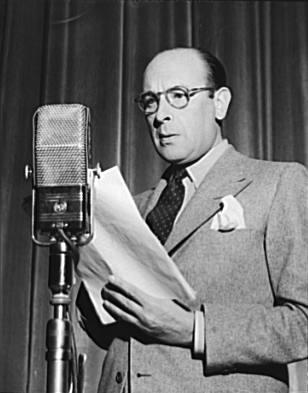
Sir Cedric Webster Hardwicke was an English stage and film actor whose career spanned nearly 50 years. His theatre work included notable performances in productions of the plays of Shakespeare and Shaw, and his film work included leading roles in several adapted literary classics.

Climax! is an American television anthology series that aired on CBS from 1954 to 1958. The series was hosted by William Lundigan and later co-hosted by Mary Costa. It was one of the few CBS programs of that era to be broadcast in color, using the massive TK-40A color cameras pioneered and manufactured by RCA, and used primarily by CBS's rival network, NBC. Many of the episodes were performed and broadcast live, but, although the series was transmitted in color, only black-and-white kinescope copies of some episodes survive to the present day. The series finished at #22 in the Nielsen ratings for the 1955–1956 season and #26 for 1956–1957.
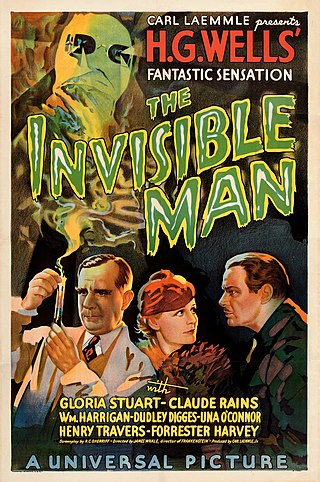
The Invisible Man is a 1933 American science fiction horror film directed by James Whale based on H. G. Wells' 1897 novel, The Invisible Man, produced by Universal Pictures, and starring Gloria Stuart, Claude Rains and William Harrigan. The film involves a Dr. Jack Griffin (Rains) who is covered in bandages and has his eyes obscured by dark glasses, the result of a secret experiment that makes him invisible, taking lodging in the village of Iping. Never leaving his quarters, the stranger demands that the staff leave him completely alone until his landlady and the villagers discover he is invisible. Griffin goes to the house of his colleague, Dr. Kemp and tells him of his plans to create a reign of terror. His fiancée Flora Cranley, the daughter of his employer Dr. Cranley, soon learn that Griffin's discovery has driven him insane, leading him to prove his superiority over other people by performing harmless pranks at first and eventually turning to murder.

Bela Lugosi (1882–1956), best known for the original screen portrayal of Bram Stoker's Dracula in 1931, performed in many films during the course of his 39-year film career. He appeared in films made in his native Hungary, Germany and New York before re-locating to Hollywood in 1928. Films are listed in order of release.

Griffin, also known as the Invisible Man, is a fictional character who first appeared as the protagonist of H. G. Wells' 1897 science fiction novel The Invisible Man. In the original work, Griffin is a scientist whose research in optics and experiments into changing the human body's refractive index to that of air results in him becoming invisible. After becoming invisible, he wraps his head in bandages and dons a pair of goggles or glasses in order to enable others to see him. Unable to reverse the invisibility process, he descends into insanity and becomes a criminal.
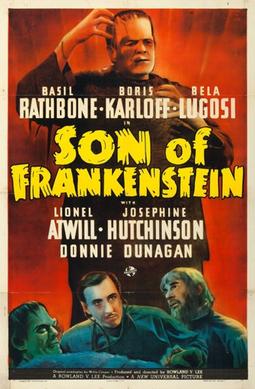
Son of Frankenstein is a 1939 American horror film directed by Rowland V. Lee and starring Basil Rathbone, Boris Karloff and Bela Lugosi. The film is the third in Universal Pictures' Frankenstein series and is the follow-up to the 1935 film Bride of Frankenstein. Son of Frankenstein stars Rathbone as Baron Wolf von Frankenstein who, with his wife Elsa and son Peter, returns to his late father's estate. Near the castle lives Ygor, a crazed blacksmith whose neck was broken in an unsuccessful hanging attempt. Among the castle's remains, Frankenstein discovers the remains of the Monster and decides to try to save his family name by resurrecting the creature to prove his father was correct. He finds, however, the Monster only responds to Ygor's commands.

The Invisible Man Returns is a 1940 American horror science fiction film directed by Joe May. The film stars Cedric Hardwicke, Vincent Price, Nan Grey and John Sutton. The film is a sequel to the 1933 film The Invisible Man, and the second film in the Invisible Man film series. The film is about Sir Geoffrey Radcliffe (Price) who is condemned for a murder he did not commit, which leads to him begging Dr. Frank Griffin (Sutton) to inject him with the invisibility serum despite Griffin's warning that the serum will drive him mad.

The Invisible Woman is an American science fiction comedy film directed by A. Edward Sutherland. It is the third film in Universal Pictures' The Invisible Man film series, following The Invisible Man and The Invisible Man Returns, the latter which was released earlier in the year. It was more of a screwball comedy than the others in the series. Universal released The Invisible Woman on December 27, 1940.
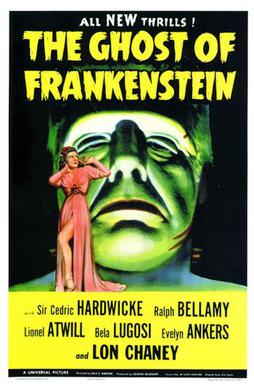
The Ghost of Frankenstein is a 1942 American horror film directed by Erle C. Kenton and starring Cedric Hardwicke, Lon Chaney Jr. and Bela Lugosi. It is the fourth film in the Frankenstein series by Universal Pictures, and the follow-up to Son of Frankenstein (1939). The film's plot follows the previous film's: Frankenstein's Monster and his companion Ygor are chased out of town. They go to another small town to encourage the younger son of Henry Frankenstein to continue his father's experiments, so that Ygor can have revenge against his enemies and his brain transplanted into the Monster's skull.

Frankenstein Meets the Wolf Man is a 1943 American horror film directed by Roy William Neill and starring Lon Chaney Jr. as Larry Talbot and Bela Lugosi as Frankenstein's monster. The script, written by Curt Siodmak, follows The Ghost of Frankenstein and The Wolf Man, though with a number of retcons. Most significantly, Talbot only transforms into werewolf form during a full moon, which became a standard part of werewolf lore. The film involves Larry Talbot, who is brought back to life when his tomb is disturbed. His search for a way to end his seeming immortality leads to his befriending Frankenstein's monster.

House of Frankenstein is a 1944 American horror film starring Boris Karloff, Lon Chaney Jr. and John Carradine. Based on a story by Curt Siodmak, it was directed by Erle C. Kenton and produced by Universal Pictures. Based on Curt Siodmak's story The Devil's Brood, the film is about Dr. Gustav Niemann, who escapes from prison and promises to create a new body for his assistant Daniel. Over the course of the film, they encounter Count Dracula, Larry Talbot, the Wolf Man, and Frankenstein's Monster.

House of Dracula is a 1945 American horror film released and distributed by Universal Pictures. Directed by Erle C. Kenton, the film features several Universal Horror properties meeting as they had done in the 1944 film House of Frankenstein. The film is set at the castle home of Dr. Franz Edelmann, who is visited first by Count Dracula and later by Larry Talbot, the Wolf Man, who are trying to cure their vampirism and lycanthropy, respectively. Talbot is eventually cured, which leads him to discover the body of Frankenstein's monster in a cave below the base of the castle. Edelemann takes the monster's body back to his laboratory but finds Count Dracula has awakened and by attacking his assistants, he captures Edelmann and forces a reverse blood transfusion, which gives Edelmann a split personality and makes him a killer.

The Invisible Man's Revenge is a 1944 American horror film directed by Ford Beebe and written by Bertram Millhauser. The film stars John Carradine as a scientist who tests his experiment on a psychiatric hospital escapee, played by Jon Hall, who takes the invisibility serum and then goes on a crime spree. The film was announced on June 10, 1943, and began shooting on January 10, 1944 finishing in mid-February. On its release, reviews in The New York Herald-Tribune, The New York Daily News and The New York World-Telegram noted that the film series and its special effects became tired, while a review in The Hollywood Reporter declared it as one of the best in the series. Although Hall’s character shares the name “Griffin” with characters in other Universal “invisible man” films, the film does not follow the continuity of the series.

The Mad Ghoul is a 1943 American horror film directed by James Hogan and starring Turhan Bey, Evelyn Ankers, and David Bruce, and featuring George Zucco, Robert Armstrong, and Milburn Stone. The film is about the scientist Dr. Alfred Morris and his assistant Ted Allison. Morris, who is obsessed with an ancient Mayan life-preserving process to the point of madness, has fallen in love with Allison's girlfriend, the concert singer Isabel Lewis. Morris decides to use Allison for his eternal-life experiments, transforming him into a zombie who slowly recalls his past life, but is unaware of his undead status.

Universal Classic Monsters is a home video line based on a series of horror films primarily produced by Universal Pictures from the 1930s to the 1950s. Although not initially conceived as a franchise, the enduring popularity and legacy of the films and the characters featured in them has led the studio to market them under the collective brand name of Universal Studios Monsters. Steve Jones of USA Today described Universal's most famous monsters as "pop culture icons", specifically Dracula, Frankenstein, the Mummy, and the Wolf Man.
Shock Theater is a package of 52 pre-1948 classic horror films from Universal Studios released for television syndication in October 1957 by Screen Gems, the television subsidiary of Columbia Pictures. The Shock Theater package included Dracula, Frankenstein, The Mummy, The Invisible Man and The Wolf Man as well as a few non-horror spy and mystery films. A second package, Son of Shock, was released for television by Screen Gems in 1958, with 20 horror films from both Universal and Columbia.
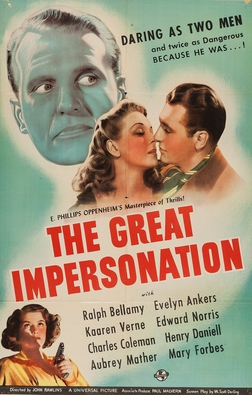
The Great Impersonation is a 1942 American thriller film directed by John Rawlins and starring Ralph Bellamy, Evelyn Ankers and Aubrey Mather. It is an adaptation of the 1920 novel The Great Impersonation by Edward Phillips Oppenheim with the setting moved from the early 1910s of the novel to the Second World War. It was made by Universal Pictures and was a remake of their 1935 film of the same name.
Works of popular culture influenced by H. G. Wells' 1897 novel The Invisible Man include:

Frankenstein is a film series of horror films from Universal Pictures based on the play version by Peggy Webling and the 1818 novel Frankenstein; or, The Modern Prometheus by Mary Shelley. The series follow the story of a monster created by Henry Frankenstein who is made from body parts of corpses and brought back to life. The rest of the series generally follows the monster continuously being revived and eventually focuses on a series of cross overs with other Universal horror film characters such as The Wolf Man. The series consists of the following films: Frankenstein (1931), Bride of Frankenstein (1935), Son of Frankenstein (1939), The Ghost of Frankenstein (1942), Frankenstein Meets the Wolf Man (1943), House of Frankenstein (1944), House of Dracula (1945) and Abbott and Costello Meet Frankenstein (1948).

The Invisible Man is a film series by Universal Pictures. The series consists of The Invisible Man, The Invisible Man Returns, The Invisible Woman, Invisible Agent, The Invisible Man's Revenge and Abbott and Costello Meet the Invisible Man. The film series borrows elements from H. G. Wells's novel The Invisible Man, but it focuses primarily on the idea of a serum that causes someone to go invisible and its side-effects.



















